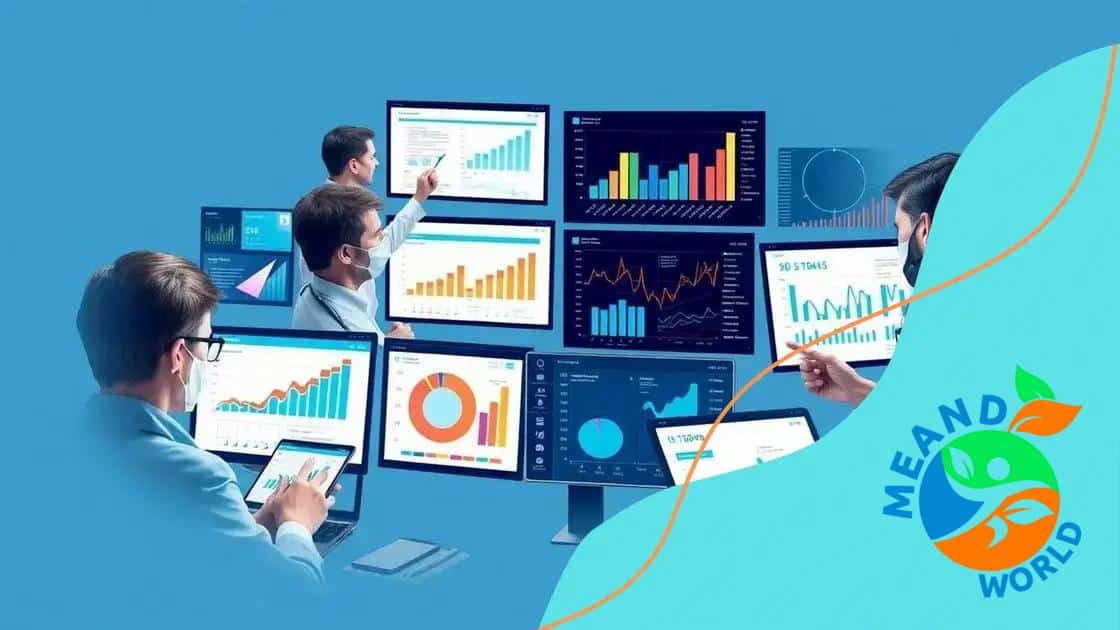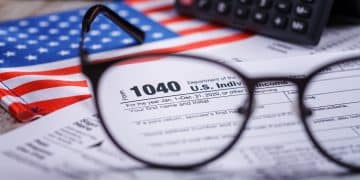The role of data analytics in predicting market trends

Anúncios
The role of data analytics in predicting market trends involves utilizing tools like AI and machine learning to analyze data, enabling businesses to make informed decisions and anticipate future market changes effectively.
The role of data analytics in predicting market trends is becoming increasingly vital for businesses. Have you ever wondered how companies anticipate shifts in consumer behavior? This article delves into how data analytics shapes market forecasting.
Anúncios
Understanding data analytics basics
Understanding data analytics basics is essential for anyone looking to grasp how businesses harness the power of their data. In today’s competitive environment, having a clear insight into data analytics can give organizations a significant advantage.
Anúncios
Data analytics involves examining raw data to uncover patterns and trends. It allows companies to make informed decisions based on concrete evidence rather than intuition alone. This process typically includes data collection, processing, and analysis.
Key Components of Data Analytics
There are several core components to understand when delving into data analytics:
- Data Collection: Gathering relevant data from various sources is the first step.
- Data Cleaning: This involves removing inaccuracies to ensure high-quality data.
- Data Analysis: After cleaning, the data is analyzed to find trends.
- Data Visualization: Finally, insights are presented using charts and graphs for easier interpretation.
By effectively using these components, companies can transform their data into actionable insights. For instance, by analyzing customer feedback, businesses can improve their products and services, creating a better customer experience.
Types of Data Analytics
There are four main types of data analytics that organizations employ:
- Descriptive Analytics: Understanding past performance through historical data.
- Diagnostic Analytics: Exploring the reasons behind past outcomes.
- Predictive Analytics: Using data to forecast future trends.
- Prescriptive Analytics: Recommending actions based on predictive insights.
Each type serves a unique purpose, helping businesses to not only look back but also plan for the future. By using predictive analytics, companies can anticipate market demands and adjust their strategies accordingly.
In conclusion, grasping the basics of data analytics is vital for making sound business decisions. By utilizing these tools, businesses can better understand their customers, streamline operations, and ultimately enhance their competitive edge.
Key tools for market prediction
Key tools for market prediction are essential in today’s data-driven world. Businesses increasingly rely on these tools to make informed decisions and anticipate changes in market trends. Understanding which tools to use can significantly enhance predictive accuracy.
There are several notable tools available for market prediction, each with unique features tailored to different business needs. Utilizing these tools effectively can streamline the forecasting process and improve overall results.
Popular Market Prediction Tools
Among the most effective tools are:
- Google Analytics: This tool helps businesses understand website traffic and user behavior, providing insights into customer preferences.
- Tableau: A powerful data visualization tool that simplifies complex data sets into understandable graphics, enhancing decision-making processes.
- IBM Watson Analytics: Leveraging artificial intelligence, this tool offers predictive analytics features that help uncover trends.
- SAS Analytics: Known for its advanced analytics capabilities, SAS provides tools for detailed statistical analysis and data mining.
By employing these tools, companies can gain insights that lead to better strategic decisions. For instance, by monitoring sales data through these platforms, businesses can identify shifts in consumer behavior, enabling them to adapt their strategies quickly.
Benefits of Using Analytics Software
The advantages of using analytical tools include:
- Improved Accuracy: Automated data analysis minimizes human error.
- Efficiency: These tools process large volumes of data rapidly, saving time.
- Enhanced Data Visualization: Good visualization makes complex data easier to interpret.
- Supported Decision-Making: Accurate predictions help businesses take timely actions.
By understanding and utilizing tools for market prediction, organizations can stay ahead of the competition and make data-driven decisions. This proactive approach is crucial for success in an increasingly complex market landscape.
Real-world applications of data analytics

Real-world applications of data analytics showcase how businesses leverage data to enhance operations and decision-making. Various industries use analytics to drive efficiency and gain a competitive edge. By analyzing data, companies can uncover valuable insights that guide their strategies.
One major application of data analytics is in the retail industry. Retailers analyze purchase patterns and customer preferences to optimize inventory and personalize marketing efforts. For example, by studying shopping habits, a store can recommend products tailored to individual shoppers’ tastes.
Healthcare Sector Innovations
In the healthcare sector, data analytics plays a crucial role in improving patient outcomes. Hospitals utilize analytics to track patient records and predict potential health risks. This proactive approach helps in:
- Reducing readmission rates: By identifying at-risk patients early, hospitals can provide necessary follow-up care.
- Enhancing treatment methods: Analyzing patient data allows for tailoring treatments to individual needs.
- Streamlining operations: Efficient scheduling based on patient flow can increase service quality.
Another significant area of impact is in the finance sector. Financial institutions employ data analytics for fraud detection. By monitoring transactions in real-time, banks can identify unusual patterns and respond quickly to potential threats. This approach significantly reduces losses and protects customer accounts.
Improving Marketing Strategies
Data analytics also revolutionizes marketing strategies. Companies can segment their audiences more effectively. For instance, by analyzing customer data, a business can create targeted advertising campaigns that resonate more with specific demographics. This targeted approach leads to higher engagement and conversion rates.
In addition to marketing, analytics is used in sports to enhance team performance. Sports teams analyze player statistics and performance data to develop strategies that boost their chances of winning. Coaches can use this information to make informed decisions during games.
The versatility of data analytics has made it an essential tool across various industries. From improving customer experiences to optimizing operational efficiency, the potential applications are truly limitless.
Challenges in data-driven predictions
Challenges in data-driven predictions can impact the effectiveness of analytics strategies. While data analytics offers valuable insights, businesses often face hurdles that can complicate the process. Understanding these challenges is crucial for devising effective solutions.
One significant challenge is data quality. Inaccurate or incomplete data can lead to misleading conclusions. Companies must ensure that the data they collect and analyze is reliable. This process often involves cleansing data to remove errors and inconsistencies.
Data Privacy and Security
Another challenge many organizations encounter is data privacy. With increasing regulations surrounding data protection, businesses must navigate compliance while using data analytics. This includes:
- Adhering to regulations: Laws such as GDPR require companies to handle personal data responsibly.
- Implementing security measures: Protecting sensitive data from cyber threats is essential.
- Educating employees: Staff must understand the importance of data privacy and security.
In addition to privacy concerns, integration of data from multiple sources can be difficult. Different systems may not communicate effectively, making it challenging to create a unified view of data. Organizations need robust integration strategies to ensure seamless data flow and accurate predictions.
Interpreting the Results
Once data is analyzed, interpreting the results poses another challenge. Simply having data is not enough; organizations must be skilled at deriving actionable insights. Misinterpretation can lead to poor decision-making, undermining the value of analytics efforts. This underscores the importance of training and having experienced professionals on the team.
Lastly, keeping up with technological advancements can also be a struggle. As new tools and methodologies emerge, businesses must stay updated to leverage the best available options. Investing in continuous education and training is essential for teams to remain competitive in a rapidly evolving landscape.
Future trends in data analytics
Future trends in data analytics indicate a rapidly evolving landscape, driven by technological advancements and changing business needs. As organizations continue to leverage data, several key trends are emerging that will shape the future of analytics.
One prominent trend is the increasing use of artificial intelligence (AI) and machine learning in analytics. These technologies allow for deeper insights and more accurate predictions by automating data analysis processes. Businesses are now able to analyze vast amounts of data in real time, making quicker, more informed decisions.
Enhanced Data Visualization
Another important trend is the advancement of data visualization tools. As data becomes more complex, the need for clear and engaging visual representations grows. Enhanced visualization techniques help stakeholders understand intricate data sets easily. Companies are likely to adopt tools that allow for:
- Interactive dashboards: These enable users to explore data dynamically and gain insights on demand.
- Augmented reality (AR): Integrating AR can provide immersive ways to interact with data visualizations.
- Real-time updates: Visualizations that update in real time allow for immediate analysis of ongoing trends.
Moreover, the trend towards predictive analytics is expected to grow. This involves using historical data and statistical algorithms to forecast future outcomes. Businesses will increasingly rely on predictive models to enhance strategic planning and risk management.
Data Democratization
Data democratization is another emerging trend that promotes wider access to data across an organization. Instead of limiting data analysis to data scientists or IT professionals, companies are focusing on empowering all employees to leverage analytics tools. This shift encourages:
- Self-service analytics: Users can generate reports and insights without needing extensive technical knowledge.
- Collaborative decision-making: Teams can collaborate based on shared data insights, enhancing creativity and problem-solving.
- Data literacy programs: Investing in training helps employees understand and use data effectively.
Finally, as businesses continue to prioritize sustainability, there will be a focus on green analytics. This involves utilizing data to minimize environmental impact and optimize resource usage. Companies will develop sustainable practices driven by insights gained from analytics.
FAQ – Frequently Asked Questions about Data Analytics
How can data analytics improve business decisions?
Data analytics provides insights from data patterns, helping businesses make informed decisions and better predict future trends.
What are some tools for data visualization?
Popular data visualization tools include Tableau, Power BI, and Google Data Studio, which help to transform complex data into understandable visuals.
What is the significance of machine learning in data analytics?
Machine learning allows for automated data analysis, enabling faster and more accurate predictions by learning from historical data.
How can organizations ensure data privacy while using analytics?
Organizations can ensure data privacy by adhering to regulations, implementing strong security measures, and training employees on data protection practices.





